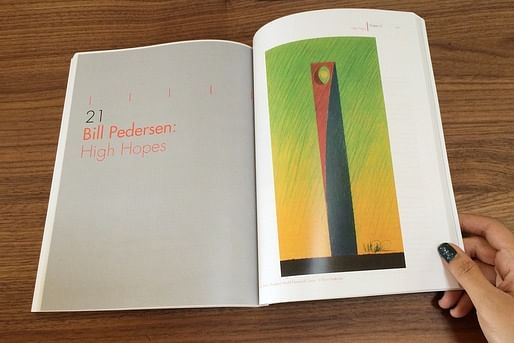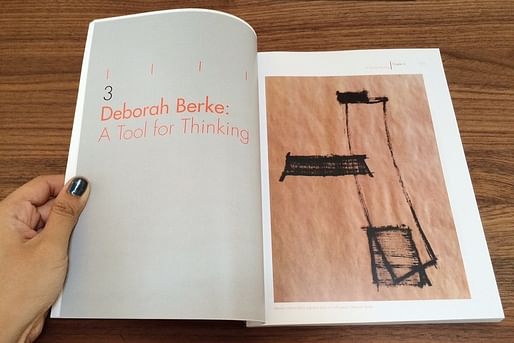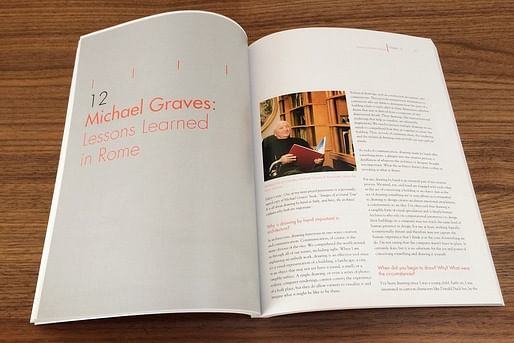
"Drawing from Practice, Architects and the Meaning of Freehand" by architectural writer J. Michael Welton is a practitioner's handy reference for freehand-drawing inspiration and an adept resource to anyone who's curious about the creative processes behind some of today's most influential architects.

The 221-page book includes more than 200 full-color drawings from an international range of architects. With ample research, Welton guides readers through the creative process of 26 of today's most prominent architects, from the initial sketch to the final product.
The book explores the drawings of:
Aidlin Darling Design, Alberto Alfonso, Deborah Berke, Marlon Blackwell, Peter Bohlin, Warren Byrd, Ellen Cassilly, Jim Cutler, Chad Everhart, Formwork, Phil Freelon, Michael Graves, Frank Harmon, Eric Höweler and Meejin Yoon, Léon Krier, Tom Kundig, Daniel Libeskind, Brian McKay Lyons, Richard Meier, Bill Pedersen, Suchi Reddy, Witold Rybczynski, in situ studio, Laurinda Spear, Stanley Tigerman, and Tod Williams Billie Tsien Architects.






With that said, Archinect is giving away five copies to our readers!
TO ENTER THE GIVEAWAY: Answer the following question in the comment section below by August 27, 2015, end of day. (NOTE: Only the first comment you submit will count toward the giveaway).
Which architect's drawings or drawing process inspires you the most, and why?
Five winners will be chosen. Good luck!
24 Comments
I don't know about drawing process, but Paul Rudolph's drawings always astound me. Such a fantastic sense of space.
I've always enjoyed seeing Lewis Tsurumaki Lewis's process drawings. They have interesting technique of combining digital renderings with hand drawings. A literal combination of old and new world processes.
For me, there isn't one singular architect drawing process that inspires me the most. For me, I employ the processes of design thinking, drawing from multiple sources.
One of my sources for design process is John E. Wicks and Ebba Wicks Brown and her husband Ernest Brown. They have a certain degree if influence in my design thinking. In part, a philosophy I hold in design. Part of design and drawing methodology comes right out the book by the American School of Correspondence, titled: "Architectural drawing and lettering : a manual of practical instruction in the art of drafting and lettering for architectural purposes, including the principles of shading and rendering, and practical exercises in design" or simply "Architectural Drawing and Lettering" (for short) by Frank A. Bourne, H.V. von Holst, and Frank Chouteau Brown as that was a source for drawing and lettering that John E. Wicks learned from when he learned his architectural drawing and lettering techniques from American School of Correspondence.
Other sources include the books by Francis d.k. Ching.
For design: Additional sources of influence comes from the book.
Synthesis 9 by William Kleinsasser.
and
also Frank Lloyd Wright through resources such as:
http://www.miltonstricker.com
and
also through the design works of John Yeon (not technically an architect from licensing law perspective).
I don't think there is a single source but when it comes with drawing, I had these skills long before pursuing building design / architecture. If I were to simply say about drawing processes, I should not ignore those people who had significant influence in learning to draw. I didn't start learning to draw when I started pursuing building design / architectural study. I more adapt skills I already have.
In which case, a personal friend of mind for whom I won't name here on a public medium, and also instructors I had which includes James Russell and Royal Nebeker and art instructors but then I had already been applying from the one and most important source of learning by practice and that's myself. As for teaching how to use a pencil or pen to draw and techniques, well, I been nailing that down myself for some time. As for the rest, I think it is more a design thinking process than necessarily a 'drawing process' or drawing techniques.
I believe for me, it is hard to pin exactly one single source or being to obsessed with a single source for everything. I believe a lot of sources provides me a diverse basis to draw from when thinking about design.
I would argue that the works of John Wicks and that of Ernest and Ebba Brown and that of their partners and associates Rod Grider, Tom Potter and to a further extent, Richard Gabriel would have some strong influence in my choosing architecture/building design and their work have a degree of connection to me as well as some other people whose work resonates with me.
I don't know if I given you any single clear way to discern a single source but I think you have to even look beyond even architects to get to all my sources and in some ways influence my particular drawing techniques.
If that is an answer, that is probably about as true an answer as you can get without a bunch of poetic b.s.
That's a tough question, so many good ones. I would say Louis Kahn before I went to college (love the relation to nature), but Tadao Ando during college years.
As most of you would know, Mr. Ando was a boxer before he became an architect. He was self-taught by tracing repeatedly the plans and facades of works by famous architects especially Le Corbusier. He learned proportions and geometries from tracing and analysing these important works, eventually deducted to squares, circles and very minimalist concrete units. While I'm not always fans of his works, I was very inspired by the way he studies. I'm very moved by his dedication.
I'm very glad to hear about this book. I know the benefits of hand drawing and concentrate study, but I have fallen into the Pinterest trap lately. When I see inspiration on Archinect, I often just Pin them and I rarely go back to look at them.
Hard to pick one, but I'd say they don't come better than Lebbeus Woods. His incredibly structured yet intensely dynamic compositions are endlessly fascinating.
Personally in terms of "the drawing process from concept to working drawings, my favorite architect is SANTIAGO CALATRAVA. (though not mentioned above) . He offers in my opinion very clear straightforward illustrations that even a layman can easily comprehend irrespective of the philosophy, principle or theory behind the work and on completion the project speaks for itself.
But with the digital era at hand, alot is changing and we are definitely going to see more sophisticated design/drawing process evolve.
I enjoy watching comic book artist Jim Lee work. He starts with a dull pencil to create the general shape of whatever he is creating. Then he works with a micron pen to really define the subject. After that, he works up in ink line size, by using various markers and brushes, to create shadow, mass, and texture. He never lets what he has done with the pencil, or finer ink lines, dictate what he does with his broader ink strokes. That is good advice for designing and life: never let what you have just done keep you from making the right choice, now.
I'm from Switzerland so, even if I like alot of different architectural works, I will say Mario Botta.
Tough question. As an italian architecture student, it is a bit hard to confess that I owe the "discovery" of the real beauty, power, and meaning of ancient and renaissance's architecture to a certain Philadelphia guy named Louis I. Kahn. Of course, before I met his works and drawings I was already aware of the legacy and the values of architecture of the past had handed down to generations 'till now, but I always missed something.
After studying his works and seeing the travel drawings that Kahn made during his grand tour in Europe, something really hit my imagination and my sense of art/beauty, especially about the brutal and massive power of the roman walls, and all the possible colour variaties of light that encounters a colonnade, or how the outer light can bring life in an indoor space.
To me, Kahn drawings - almost like Piranesi famous views of roman ruins - are the most inspiring and touching representations of the moment in which a feeling meet a buildings.
One that captures my imagination is Antonin Gaudi and his façade for Casa Batilo, for example- so much detail is included, yet so much is left out and ethereal, leaving room for the mind to interpret. I do not fancy myself a good sketch-ist nor do I my personal architectural style is very akin to Gaudi. Perhaps that is the basis for some of the admiration and of a well done sketch.
Alvaro Sizà. they have a childlike quality, but gather so much information, space, light, materiality in so few strokes.
for me it's always been steven holl. the exploration through drawing and watercolor that establishes the conceptual basis of each project and then the discipline to follow through. a discipline that assures that the realized project is always true to the original exploration, but makes it richer through subsequent material exploration and resonant through detailing which supports the original thoughts.
James Cutler has always inspired me with his clarity in drawing, and deeply impressed how that clarity translates in design.
I've always really liked Renzo Piano's sketches and drawings
I like Carlo Scarpa's drawings.
Gehry's sketches inspire me most
and from them they cause me to post
from out of chaos
built work becomes boss
in vitra I wish I were a ghost!
Renzo Piano - especially his sectional sketches. They usually have just enough lines to communicate the architectural language and intent of the project. I also like the way he uses color to establish hierarchy and talk about where the life and vibrancy are happening in the more public areas of his designs.
Lebbeus Woods - Most of his work are drawings. He was able to depict a world most of can't imagine and he did so using hand drawings. He had such a great talent and is surely missed in the world of Architecture.
Stephen Holl's full page colored pencil and pastel sketches have continued to inspire me for their realization of an atmosphere. He uses rich color sketches to express texture, light, material and form in a way that feels loose but is grounded in reality of form. His ability to express the poetics of a space from the inhabitant/ users perspective takes the creative possibility of space and generates a tangible angle. I admire his exploration of a variety of scales from the micro to the city with pencils and his hands. Very visceral.
Zaha's early drawings & paintings ("The Peak Leisure Club", etc.) have always captured my attention with their dynamism and spatial qualities. I am really interested in the way those images are then translated into built (or unbuilt) architectural forms.
Holl without a doubt, he's the master of transforming a sketch into an actualized design. His sketches become his buildings, they don't just inform the small details so much as they dictate the outcome of any of his projects.
Of the Hejduk, Woods, Abraham line of architect/artists, the one person often overlooked is Walter Pichler. His drawings, models and architecture did things the others could not - and I adore them all - connect the craft of drawing, with the narrative of architecture, and the realized form. I will always admire those that create works where the hand drawing the thing, and the hand building the thing, and rendered nearly inseparable. Pichler's oeuvre does that for me, his work is that to which I aspire.
Which architect's drawings or drawing process inspires you the most, and why?
The drawings and process of my own inspires me the most. Why? Because it is the purpose of sketching. There is no other example in which I am personally involved so much. You can not go through other person's process. Only through your own. But you can guess what was he thinking... :)
COMMENTING IS NOW CLOSED. Thanks for all your responses, everyone. Winners will be announced soon.
Block this user
Are you sure you want to block this user and hide all related comments throughout the site?
Archinect
This is your first comment on Archinect. Your comment will be visible once approved.